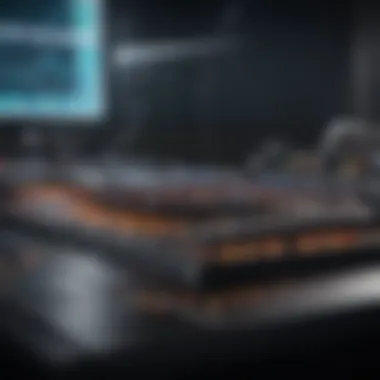Crafting a Hit Song in Minimal Time: A Quick Guide


Intro
Crafting a memorable song swiftly isn’t just a whimsical journey; it’s an art, a science, and a dance of creativity. In a world where music continuously evolves, finding a way to create a hit in minimal time can feel like chasing shadows. Yet, it’s entirely a doable feat with the right approach. This piece lays bare an efficient methodology aimed at musicians, songwriters, and enthusiasts who find themselves craving to tap into their songwriting prowess right when inspiration strikes.
Through exploring the nuances of melody, lyrics, and overall structure, we'll shine a light on what elevates an ordinary musical composition into something remarkable. While the common belief might lean towards longer efforts birthing better art, this article will debunk that myth, championing the beauty of simplicity and rapid creation.
Artist Profile
Biography and Background
Let’s consider the concoction of tasks behind crafting a hit song, and who better to lead us through this than a contemporary artist who encapsulates the spirit of modern songwriting? Take Billie Eilish, for instance. Raised in a creative environment where both her parents were musicians, Billie’s eerie yet captivating sound stems from her early exposure. Born in 2001 in Los Angeles, she began recording songs at just 14, apparently separating herself from the typical music noise and honing her craft in an atypical manner.
Despite her youth, her career trajectory has shown that raw talent combined with a strikingly poignant perspective can yield phenomenal results. Thus, understanding her unique profile not only provides context but also ignites inspiration in aspiring songwriters.
Major Influences and Inspirations
Billie's music is influenced by a unique blend of eclectic sources. She has cited artists like Lana Del Rey, The Beatles, and even hip-hop icons like Tyler, the Creator, as poignant forces shaping her sound. Each of these influences contributes to her distinctive mixing of genres and innovative storytelling, echoing the notion that inspiration can come from the most unexpected corners of the music sphere.
Understanding these influences can help songsmiths navigate their own journeys, connecting with what resounds with their spirit in this vast musical landscape.
Song Analysis
Theme and Lyrics Breakdown
A hit song resonates, not just melodically but through its lyrics. Take Eilish’s track "Bad Guy," as an example. It skillfully combines irony with confidence, showcasing a narrative that's both playful and assertive. The lyrics exhibit a relatable essence—a perfect potion for listeners looking to identify with a deeper meaning while also enjoying an infectious groove.
When dissecting lyrics, pinpoint the primary theme and explore ways of conveying emotions through words—less is often more. The audience connects with authenticity, leading to widespread appeal that transcends genres.
Instrumentation and Composition
In the realm of instrumentation, sometimes simplicity reigns supreme. The incorporation of minimalistic beats paired with synth fills sends a refreshing jolt through the listener's experience. For instance, in her song "Ocean Eyes," the ethereal soundscape effortlessly complements heartfelt lyrics, demonstrating that less can indeed be more.
When crafting a song, focus on:
- Melody: Aim for a catchy, repeatable hook.
- Rhythmic Variability: Experiment with timings and pacing.
- Harmonic Structure: Don’t shy away from unusual chord progressions.
"At the intersection of simplicity and technique lies the blueprint for a hit." - An Encouraging Thought
As we unfold the components of songwriting, remember that the ultimate aim is to evoke emotions, challenge perceptions, and create connections through a piece that is instinctively expressive.
Understanding the Songwriting Process
Understanding the songwriting process is the backbone of quickly crafting memorable and impactful songs. When an artist is aware of the pivotal steps involved, it can lead to a significant improvement in efficiency and creativity. The process is not merely a checklist but a dynamic interplay of elements that enriches the final product. It serves both as an art and a science. By grasping the essentials, songwriters can streamline their efforts, allowing for the emergence of strong musical concepts in minimal time.
The approach taken by many successful songwriters is notably intricate, yet the ability to emphasize key aspects can often yield better results in a shorter timespan. Recognizing the pivotal features that contribute to a hit song can vastly assist in targeting creative energies toward what resonates most with listeners.
The Essence of Songwriting
At the heart of songwriting lies the delicate balance between creativity and technicality. It is not just about stringing together a few chords and catchy phrases. Instead, it’s about expressing genuine feelings, connecting with audiences, and offering something fresh. Each note, rhythm, and word must blend seamlessly to create a piece that stands out in a crowded musical landscape.
Songwriting is a form of communication. It's an art where the intent is to convey emotions and thoughts that the listener can latch onto. It requires a level of introspection and reflection, often steering the songwriter to explore their own experiences and insights. Through this journey, they can translate complex concepts into simple, relatable songs that resonate with a broad audience.
Key Elements of a Hit Song
Understanding what makes a hit song is essential for conveying emotion and achieving artistic expression. There are three primary elements that stand out as crucial: catchy melodies, relatable lyrics, and compelling structures. Each of these components plays a distinct role in crafting a song that listeners can't shake off.
Catchy Melodies
Catchy melodies can make a song memorable; they’re often the hook that draws listeners in. A melody doesn't need to be complex to be effective. In fact, many chart-toppers rely on simple, repetitive motifs that are easy to remember and sing along to. The signature characteristic of a great melody is its ability to evoke a feeling or memory. Therefore, when people hear a tune, they often think of a specific moment related to that song.
Unique features such as rhythmic variation or unexpected intervals can elevate a melody beyond the ordinary. However, caution must be exercised—there’s a fine line where a melody can become repetitive to the point of annoyance. Maintain a keen ear for balance in creating something that sticks without becoming tiresome.
Relatable Lyrics
Relatable lyrics connect the songwriter with their audience. They serve as the narrative thread that people can hold onto and identify with. When lyrics mirror the experiences, aspirations, or emotions of listeners, it creates an instant rapport. The primary characteristic of relatable lyrics is their universality; they touch on themes like love, heartbreak, or celebration that are recognizable to many.
An unmistakable feature of such lyrics is their conversational tone; they often read like a dialogue one might have with a friend. This makes the content easier to digest for listeners. Yet, there’s a potential downside: overly simplistic lyrics could fail to resonate with more discerning audiences looking for depth. Balancing simplicity with depth is key.
Compelling Structure
A compelling structure is often overlooked but is crucial for maintaining listener engagement. The layout of a song—how verses, choruses, and bridges are arranged—should facilitate an enjoyable listening experience. Familiar structures like verse-chorus-verse are appealing because they form a predictable yet effective pattern that creates anticipation.


Moreover, a unique verse-chorus-bridge arrangement can set a song apart and create an element of surprise. This aspect of songwriting emphasizes the importance of diversity within the framework. While adhering to common structures helps, experimenting can yield interesting results. Artists may discover that breaking the mold serves not just their vision but also enriches listeners' experiences.
Setting the Stage for Creation
Creating a hit song isn’t just about what you do when the pen hits the paper or the fingers touch the keys. It’s about setting up the right environment and getting your mind in the right space before you dive into the technical aspects. In the world of songwriting, preparation can make or break your creative flow. The essence of this phase revolves around two pivotal components: crafting a conducive environment and ensuring mental readiness. Striking the right balance between these aspects will serve as a springboard for your musical ideas.
Creating the Right Environment
Minimizing Distractions
When trying to jot down that perfect melody, distractions can be the bane of your existence. Minimizing distractions helps focus your thoughts and energy on the songwriting process. Imagine trying to write while the TV blares and the phone buzzes incessantly; it's an uphill battle. In a setting where you can reduce these interruptions, you can think more clearly and tap into your creativity, leading to a more efficient songwriting session.
A key characteristic of minimizing distractions is the dedicated workspace. This could be a corner of a room with your instruments, a cozy café, or even a park bench—wherever you find peace. This unique feature allows you to create a space that feels like a haven for creativity. The main advantage here is your mind becomes a blank canvas for songs without the clutter of external noise. However, the downside can sometimes mean that isolation may lead to feelings of loneliness, which can affect certain writers.
Gathering Inspiration
Once you've stripped away distractions, you must invite inspiration into your workspace. Gathering inspiration is all about fueling your creativity with external stimuli. Whether it's other songs, nature, or art, pulling in diverse sources can lead to unexpected breakthroughs. For authors, varied experiences can spawn new ideas, making this characteristic essential for crafting a hit song.
The unique feature of gathering inspiration is the variety of methods available. You might listen to a range of music styles, revisit childhood memories, or even walk through a bustling market. This method keeps boredom at bay and your imagination alive. The primary advantage? You never know what spark might ignite your next greatest hit! But on the flip side, too much inspiration can overwhelm and confuse, diverting your focus from what you initially set out to create.
Tools and Instruments
Now that the stage is set for inspiration, let’s talk about the practical side: Tools and instruments. The right tools can facilitate the songwriting process in significant ways. These could include a robust digital audio workstation, a simple guitar, or even just a notepad and pen. Having your essentials in hand makes the setting conducive to creativity and experimentation.
The hallmark of tools and instruments lies in their variety and functionality. Each instrument adds a unique layer to your sound and can indeed be the difference between a so-so song and a masterpiece. The advantage of having these tools readily available is that they can help streamline your creative process; no fumbling around looking for the right app or keyboard. Yet, it’s important to remember that sometimes reliance on too many tech gadgets can stifle pure creativity, leading you to overthink simple ideas.
Mental Readiness
Mindfulness Techniques
When you've got your environment set, it’s time to dive into Mental Readiness. This is where mindfulness techniques come into play, allowing you to develop a focused mindset. Engaging in mindfulness before you write can help calm the noise in your head and clarify the direction you want to take with your song. Techniques like deep breathing, meditation, or even journaling can ground you.
One of the major characteristics of mindfulness techniques is the present moment awareness they cultivate. This is particularly beneficial for songwriters as it helps direct your attention solely to the act of creation, filtering out worries and distractions. The unique feature here is the practice of being wholly engaged, which can lead to breakthroughs in creativity. On the downside, not all writers may find traditional mindfulness techniques helpful; some might feel they stifle rather than encourage creativity.
Creative Visualization
Another corner of mental preparedness is creative visualization. This involves picturing your song in your mind before you even write a note. By visualizing the outcome you want, you can guide your creative process more effectively, fostering a more intentional experience. It's about seeing the full picture—understanding how lyrics and melodies will come together before they hit the paper or keys.
The strength of creative visualization is its potential to reduce anxiety—after all, when you know what you want to create, you approach it with more confidence. This unique method can also trigger your subconscious mind to begin formulating ideas. However, there is a risk here; some may spend too much time visualizing and too little on actual writing, stunting their creative flow.
"A good song is like a well-structured building—everything has to fit. The foundation is your preparation, lighting is your inspiration, and the decor is your style."
In summation, the stage you set plays a crucial role in crafting that hit song, guiding your journey from idea to completion. Your environment and mental readiness can make all the difference, affecting creativity and output profoundly.
The Five-Minute Framework
In the fast-paced world of music creation, timing can be everything. The Five-Minute Framework offers a streamlined approach to songwriting, emphasizing ingenuity and efficiency. This method not only helps in crafting melodies and lyrics rapidly, but it cultivates a mindset geared towards spontaneous creativity. By focusing on concise methods for ideation, melody development, and lyric crafting, musicians can transform fleeting inspirations into polished pieces with remarkable speed.
Rapid Ideation Techniques
Brainstorming Ideas
Brainstorming Ideas acts as the spark that sets the entire creative process in motion. It involves generating a flurry of concepts without any judgement, allowing the chaotic flow of thoughts to take center stage. This technique is particularly valuable as it embraces spontaneity and eliminates overthinking, which can stifle creativity. A big bonus is that it allows for dazzling connections between seemingly unrelated concepts, creating a fertile ground for originality.
Unique to brainstorming is its lack of structure. That freedom can bring delightful surprises, turning a simple thought into a comprehensive idea worth exploring further. However, one has to watch how easily it can veer off course. Without some level of focus, you might find yourself spiraling into an abyss of unconnected ideas, which could make the next steps more challenging than necessary.
Using Prompts and Themes
Using Prompts and Themes introduces a framework to creativity while retaining a sense of freedom. Essentially, it offers a starting line that helps guide the thought process, making it easier to develop ideas into full-blown songs. This method highlights the key characteristics of inspiration and direction combined. By setting themes or using creative prompts, songwriters can harness imagery, emotions, or concepts that resonate deeply with potential listeners.
The particular benefit of working with prompts is that they can jumpstart the creative engine, especially during times when one might feel mentally blocked. But there can be a double-edged sword; if one becomes too reliant on prompts, it might inhibit personal expression and the organic flow of musical artistry. True talent shines when the ideas still relate back to personal experiences, making authenticity crucial to maintain.
Melody Creation
Starting with Simple Chords
Starting with Simple Chords gives songwriters a solid foundation upon which to build intricate melodies. This approach promotes simplicity, keeping things relatable and easy for both the composer and the listener. By sticking to basic chord patterns, one can focus on the elements that fit right into the Five-Minute model without getting lost in complex musical theory.
The key appeal of this method is its accessibility; even the most novice player can grab a guitar or keyboard and start crafting a song in no time. Still, one must be cautious; while embracing simplicity, there’s a risk of falling into mundane patterns. Thus, the challenge lies in breaking free from the ordinary to create something that still feels fresh and engaging.
Utilizing Scales and Intervals


Utilizing Scales and Intervals dives into the fundamental building blocks of music and offers boundless opportunities for melody creation. This technique is rooted deeply in music theory, giving seasoned musicians a rich toolbox for creating everything from catchy hooks to nuanced melodies.
Scales bring structure to creativity and allow for exploration beyond the basics. But for those less familiar with musical theory, it could feel daunting. If one isn’t careful, they might feel overwhelmed by the complexities. Yet, when done right, this method can elevate a track, adding depth and character that resonates well with listeners.
Lyric Generation
Word Association Techniques
Word Association Techniques form a bridge from nebulous concepts to concrete lyrics. This method allows songwriters to jot down words that spring to mind when thinking about a theme or an emotion, shedding light on phrases and ideas that might have otherwise gone unnoticed. It fosters a sense of playfulness and can lead to unexpected lyrical connections that capture attention.
Its charm lies in its spontaneity, offering a dimensional aspect to lyrics that might reflect deeper meanings or even humor. However, a potential downfall is if songwriters become too reliant on this method, resulting in lyrics that lack depth or cohesion. Finding balance is essential here to ensure that creativity flows while still connecting to a meaningful narrative.
Cultivating Emotional Resonance
Cultivating Emotional Resonance is about forging a profound connection between the song and its potential listeners. This technique goes beyond mere words; it’s about weaving stories and emotions that tug at the heartstrings. The beauty of this approach is its universal appeal; a well-crafted line can resonate across diverse demographics, transcending cultural barriers.
By tapping into genuine feelings and shared human experiences, a songwriter can create an emotional landscape that enhances the overall impact of the piece. Nevertheless, it requires sincerity and introspection, which can be daunting for some. If not approached with authenticity, lyrics can come off as disingenuous, failing to truly resonate. Thus, it calls for a delicate balance of vulnerability and creativity.
Structuring the Song
Structuring a song is often like building a house. Without a solid framework, no matter how great the materials are, the structure risks crumbling. When crafting a hit song, a well thought out structure can elevate the composition and guide listeners through an emotional journey. It allows songwriters to play with tension and release, drawing the listener in with familiarity while adding distinguishing flair that keeps them engaged. A successful song structure is not just about organization; it's about creating a flow that resonates with the audience.
The Importance of Song Structure
The structure of a song acts like a roadmap, giving both the songwriter and the audience a clear path to embark on. Each section serves a specific purpose, be it establishing themes, expressing feelings, or delivering memorable lines. Understanding the significance of song structure isn't merely a technical necessity; it's a way to harness the listener's emotional response and craft a narrative.
Common Structures in Hit Songs
When diving into common structures in hit songs, one may find several familiar patterns that resonate through the decades. The classic verse-chorus model remains popular, thanks to its ability to create catchy and memorable snippets that linger in the ear long after the song is over. For example, a typical pop song might follow the structure of Verse 1, Chorus, Verse 2, Chorus, Bridge, and then return to the Chorus. This straightforward approach allows for effective storytelling and ensures the hook is reinforced at key moments.
However, it’s worth noting that predictability can become a double-edged sword. While adhering to popular structures can make a song more accessible, there's also a risk of blending into the sea of similar-sounding tracks. Hence, one unique feature of such structures is their adaptability. By slightly tweaking the order, inserting unexpected turns, or blending genres, songwriters can breathe new life into a well-tread road.
Creating Hooks and Bridges
Creating hooks and bridges is almost like sprinkling a bit of magic throughout a song. The hook usually encapsulates the core emotional theme, while the bridge offers a contrasting perspective. A well-crafted hook has the power to become the earworm that audiences can't shake off. Think of hooks as the catchy phrases or melodies that people will hum long after hearing the song, making them vital for commercial success.
On the flip side, crafting an effective bridge can be a balancing act. It's meant to break the monotony, offering listeners a brief respite before the final chorus hits. Surprisingly, the bridge can be where experimental sounds or lyrics reside, providing a fresh aspect that heightens anticipation for what comes next. Leveraging this unique feature can lead to a more dynamic listening experience, although, choosing the right moment to insert a bridge requires careful consideration to avoid disrupting the song's flow.
Finalizing the Composition
When it comes to finalizing a song's composition, incorporating rapid editing techniques can be key in refining the output. Writers, much like sculptors, often end up with more material than necessary, needing to chisel away the excess to reveal the masterpiece beneath. Rapid editing techniques can streamline this process. By allowing oneself to revisit ideas quickly and make necessary adjustments without overthinking, the songwriter maintains a fresh perspective. Moreover, this method fosters a sense of urgency, pushing the musician to focus on what genuinely resonates.
Rapid Editing Techniques
Rapid editing techniques enable an artist to condense their ideas efficiently. By setting strict time constraints for revisions, a creator may find themselves more decisive about what stays and what goes. For instance, one could choose to edit in thirty-minute blocks, making concise decisions based on the emotional impact of each line or section. This characteristic lends itself well to the expedition of completing a song, steering clear of the pitfall of perfectionism that can stall progress.
However, quick edits aren’t without drawbacks. It may lead to overlooking subtleties or deeper meanings embedded within the lyrics. Keeping that balance between speed and depth might take practice, but it can greatly enhance the final product's polish and emotional resonance.
Gathering Feedback Quickly
Another vital facet of the finalizing process is gathering feedback quickly. Once a draft is complete, having fresh ears listen can provide invaluable insight. Rapid feedback allows songwriters to identify strengths and weaknesses in real-time, enabling faster iterations and improvements. Involving trusted friends or fellow musicians in this part of the process fosters collaboration, which can surface ideas that the original songwriter may have overlooked.
Yet, sometimes feedback can complicate the creative landscape. One must balance between listening to critiques and staying true to their initial vision. It's crucial to discern constructive criticism from mere opinion – not every suggestion will lead to a better song. When done judiciously, gathering feedback can enhance the composition's overall quality, ensuring that it appeals to a broader audience while remaining artistically authentic.
The Role of Technology
As we dive into the process of creating a hit song, it's crucial to acknowledge the profound impact technology has had in the musical landscape. In a world that's ever-changing, the tools and resources available have shaped how music is composed, produced, and shared. For today's musicians and songwriters, embracing these technological advancements is not just an option; it’s essential for streamlining the creative process and crafting songs that resonate with audiences.
Software and Tools for Musicians
Digital Audio Workstations
Digital Audio Workstations, or DAWs as they are popularly known, play a pivotal role in modern music production. These powerful software platforms allow musicians to record, edit, and produce their music right from the comfort of their own homes. One key characteristic of DAWs is their flexibility, enabling artists to manipulate audio and MIDI with unprecedented precision.
Among the many options available, Ableton Live shines for its intuitive interface and robust features like session view, which lets you experiment with clips in a non-linear way. This is particularly beneficial for songwriters looking to explore different arrangements without feeling constrained by traditional song structures. However, a downside is that the learning curve can be steep if you’re not tech-savvy.
In summary, Digital Audio Workstations provide an essential backbone for song creation, offering tools that make production faster and more efficient while also bringing a level of professional quality to the final product.
Mobile Applications for Songwriting
In the age of smartphones, mobile applications have become invaluable tools for songwriters on the go. These apps allow musicians to jot down lyrics, record melodies, and brainstorm ideas wherever inspiration strikes. Some of the most popular ones include GarageBand for its user-friendly interface and SongMemo, which helps capture fleeting musical thoughts with ease.


The standout feature of these mobile applications is their accessibility. You can instantly capture an idea as it comes to you, which can be a game changer for maintaining your creative flow. However, while they provide convenience, some users find that the limited functionality compared to full DAWs can be a drawback, particularly for intricate musical projects.
Leveraging Online Resources
Collaborative Platforms
Collaboration among musicians has taken on new dimensions with digital platforms that connect creators from all corners of the globe. Websites like Soundtrap and BandLab allow artists to work together in real time, regardless of geographical barriers. The essence of these platforms lies in their ability to foster a communal environment where ideas can flow freely and peer feedback can be integrated seamlessly.
A noteworthy characteristic is the ability to record directly into the platform, simplifying the process of creating and swapping ideas. However, tech issues or slower internet connections can sometimes hinder the workflow, so having a reliable setup is important for maintaining efficiency in collaborative projects.
Vocal and Instrumental Samples
The realm of vocal and instrumental samples is another frontier that technology has transformed. Online libraries, like Splice or Loopmasters, provide songwriters access to an extensive selection of sounds, making it easier than ever to find the perfect riff or vocal line that complements their vision.
One of the defining features of these resources is their versatility; artists can find anything from orchestral sounds to electronic beats, blending different genres in ways that were previously labor-intensive. On the flip side, with so many options at one's fingertips, there’s a risk of drowning in choices, which can complicate decision-making and prolong the creative process.
"In the realm of song creation, technology isn’t just a tool; it’s a creative partner that can amplify every note you play and every lyric you write."
Post-Creation Considerations
Creating a hit song doesn’t end once the last note has decayed; there’s a whole world of reflection and strategic movement that comes next. Post-creation considerations are crucial. This stage is where the real artistry often emerges; it’s about analyzing what you’ve produced and planning for its future.
Evaluating Your Work
In this part of the songwriting journey, evaluating your work holds paramount importance. This is where you reflect on your composition to fess up its strengths and shortcomings.
Self-Critique Approaches
Self-critique approaches are instrumental in honing your craft. By examining your work through a critical lens, you can identify aspects that resonate and those that fall flat. The key characteristic of self-critique lies in its subjectivity. Unlike external evaluations, it relies on your personal standards and insights. This thought process is both beneficial and popular among artists, as it allows for growth without the added pressure of external judgment.
A unique feature of self-critique is its immediacy. You hold all the cards; it can be as informal as jotting down notes right after the creation process in your notebook or voice memos on your phone. The advantage here is that it’s truly your voice shaping your evaluation, but it comes with a disadvantage—bias. Often, we can be too close to our work, missing glaring issues that an outside observer may catch.
Peer Review Strategies
Peer review strategies also play a significant role. Sharing your work with trusted friends or peers can yield fresh perspectives. The main characteristic of peer review is collaboration. It creates a supportive environment where multiple viewpoints can flourish, often leading to breakthroughs you didn’t see coming. This strategy is beneficial as it provides a larger snapshot of how your song might be received by the general audience.
The unique feature of peer review is the potential for constructive criticism. Having someone challenge your choices can be enlightening and help tailor your piece into a more polished version. Still, there are downsides. You might encounter conflicting opinions that can swirl you into confusion. Not all feedback is created equal. Sorting through various comments to find those that resonate with your vision can be tricky.
Next Steps in Music Production
Once you're satisfied with your work, it’s time to think about the next steps in music production. This path is about bringing your ideas into the sonic realm and reaching an audience.
Recording Techniques
Recording techniques represent a vital piece of the puzzle. The quality of your recording can make or break a song. The key characteristic of these techniques is their variety. From studio sessions to home recordings with a simple setup, the options are nearly endless. Utilizing effective recording methods is beneficial for ensuring that your music sounds as good as it possibly can.
A unique feature of modern recording approaches is how accessible it is. With tools available for almost any budget, you can achieve professional sounds at home. This is empowering, but there’s a downside—learning curve. Without the proper guidance, many aspiring musicians find it easy to muddle through the recording process, leading to frustrations.
Distribution Channels
Lastly, explore the distribution channels available for your masterpiece. The first essential aspect of distribution is the process of getting your music heard. Channels like Spotify, Apple Music, and even Bandcamp allow artists to share their work with a wider audience. The key characteristic here is reach. With the digital age, your songs can travel far and wide in mere moments.
One unique feature of modern distribution is the role of algorithm-driven playlists. Getting your track onto popular playlists can dramatically increase your exposure. The advantage here is clear: a broader audience means more streams, and potentially more fame. However, the disadvantage is this doesn’t ensure direct connections. An artist might gain listeners but find it difficult to establish a loyal fanbase if they rely solely on algorithms.
"The difference between an artist and a hitmaker often lies not just in the creation but in the strategic thinking around what comes next."
Navigating the post-creation realm effectively helps sculpt the journey of your song from mere creation to impactful presence in the music scene.
Ending
As we wrap up our discussion on crafting a hit song swiftly, it’s essential to reflect on the significance of this process. The journey of songwriting can sometimes feel daunting, but with the right approach, any musician can navigate through it efficiently. The key takeaway here is not just the speed but the quality and intent behind the creation.
Breaking down the songwriting process into manageable pieces allows for a heightened focus on each element. Melodies, lyrics, and structures play a pivotal role, and understanding their connections can profoundly impact the song’s overall appeal.
Importance of Efficient Creation
Being able to create compelling music in a short timeframe opens doors for greater production and experimentation. Here are some vital elements to consider:
- Time Management: Shortening the time spent on each phase encourages quicker decision-making, which can often lead to more genuine creativity.
- Flexibility in Creativity: Fast-paced songwriting can break the mold of perfectionism, allowing artists to tap into raw emotions and ideas that might otherwise remain hidden.
- Maintaining Momentum: A rapid pace keeps the enthusiasm alive. When inspiration strikes, capturing it swiftly ensures that the momentum is not lost.
“To create is to live; to create quickly is to thrive.”
Benefits of Structured Reflection
Reflecting on the songwriting journey helps consolidate the insights gained throughout the process. Here are some reflections worth noting:
- Growth Mindset: Recognizing that songwriting is an evolving process fosters resilience and a willingness to experiment.
- Peer Feedback: Engaging with others can provide new perspectives, reinforcing the notion that no song is written in isolation.
- Incorporating Lessons: Each songwriting experience, whether it leads to a hit or not, carries lessons that can inform future endeavors.







